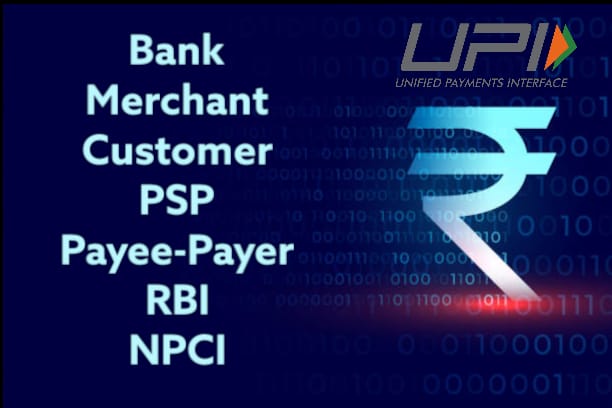UPI is a payment system introduced by the National Payments Corporation of India (NPCI) in April 2016. It is a system led by banks that enables customers to make quick and immediate payments using their smartphones. We will also be explaining all about UPI Switch Stack ahead.
Benefits of UPI for Merchants
- UPI offers merchants a low–cost and efficient way to receive payments.
- UPI payments are credited to the merchant‘s bank account in real–time, which allows them to keep track of their finances more easily.
- UPI also allows merchants to accept payments from customers without having to share their bank account details or other personal information.
- It allows merchants to create and manage invoices easily.
Participants in a UPI Switch Stack
To process a UPI transaction, the following participants are involved:
1. Payer app/PSP: PSP stands for a Payment Service Provider. Payer PSPs are apps that allow customers to initiate/complete transactions. For example: Gpay, Phonepe, Bhim, PayTM, etc.
2. National Payments Corporation of India (NPCI): NPCI is a non-profit org set up by RBI and funded by different major banks. It acts as a trusted switch to connect banks and Payment service providers (PSPs). Similar to the role played by VISA in the case of Card payments, NPCI makes sure that data flow between banks and payment apps are routed to the correct and verified destinations.
3. Issuing Bank (Sender’s Bank): In the case of UPI payment, the money is transferred from the issuing/sender’s bank account to the acquiring (merchant/receiver’s) bank account. The issuing bank has to debit money on NPCI’s request and send a debit response to NPCI once the debit is successfully done.
4. Acquiring Bank (Receiver’s bank): The acquiring (receiver) bank’s job is to credit money on NPCI’s request and send a credit response to NPCI once the credit is successfully done.
5. Payee PSP: This is the acquirer or payment gateway used by the merchant in the case of P2M (Person to Merchant) transactions.
Type of UPI Transactions
In the UPI (Unified Payments Interface) system, there are two types of transactions: P2P (Person-to-Person) transactions and P2M (Person-to-Merchant) transactions.
- P2P Transactions: P2P transactions are when you send money to another person. It could be your friend, family member, or anyone you want to give money to. You can use P2P transactions to split bills, repay loans, or send money to someone. To make a P2P transaction, you need to use a UPI-enabled app. You enter the other person’s UPI ID (like their phone number or virtual payment address) and the amount you want to send. Once you confirm the transaction, the money is immediately deducted from your bank account and added to the other person’s bank account.
- P2M Transactions: P2M transactions are when you pay a merchant or a business for something you bought or a service you used. It allows you to make payments at physical stores or online platforms. To make a P2M transaction, you can scan the merchant’s QR code using your UPI app or enter their UPI ID manually. Then, your app shows you the payment details, and you confirm the transaction by entering your UPI PIN. The payment happens instantly, and the money is deducted from your bank account and credited to the merchant’s account.
P2P and P2M transactions in UPI provide easy and quick payment options, reducing the need for cash transactions. They make it convenient to transfer money between people and pay businesses without any hassle.
What is a UPI Switch
In this module, we will delve into the concept of a UPI Switch and its significance in facilitating seamless transactions through the Unified Payments Interface (UPI) system. As a Payment Service Provider (PSP), understanding the inner workings of the UPI Switch is essential to ensure efficient and secure transaction processing for our customers.
Understanding the UPI Switch
- Definition: The UPI Switch serves as a technological infrastructure that acts as a central platform for routing and processing UPI transactions.
- Purpose: The primary objective of the UPI Switch is to enable interoperability among banks, PSPs, and UPI-enabled applications, allowing transactions to be successfully completed across different platforms and participants.
- Key Functions of the UPI Switch:
- Transaction Routing: Acting as an intermediary, the UPI Switch receives transaction requests from customers and directs them to the relevant banks or PSPs involved in the process.
- Verification and Authentication: The UPI Switch verifies the authentication credentials provided by the customer, ensuring secure and authorized transactions.
- Validation and Notification: It handles essential validations and notifications, facilitating smooth transaction processing and keeping all participants informed about the transaction status.
- UPI Switch and Interoperability:
- Interoperability Definition: Interoperability refers to the seamless integration of different systems and platforms.
- Role of the UPI Switch: The UPI Switch plays a crucial role in achieving interoperability within the UPI ecosystem. It ensures that a transaction initiated from one UPI app can be successfully processed with another UPI app, regardless of the bank or PSP involved.
- Enhancing Customer Experience with the UPI Switch:
- Seamless Transactions: Thanks to the UPI Switch, customers can enjoy a hassle-free experience when making UPI transactions. They can effortlessly send money to any UPI user or make payments to merchants, regardless of the specific UPI app or bank they use.
- Instant and Secure: The UPI Switch processes transactions in real-time, providing instant payment transfers. Moreover, it ensures the security and integrity of transactions through robust verification and authentication processes.
Key Factors to Consider When Choosing a UPI Switch Stack Provider
Selecting the right UPI Switch provider is crucial for Payment Service Providers (PSPs) and businesses seeking to integrate the Unified Payments Interface (UPI) into their operations. To ensure a smooth and efficient payment experience, it is important to consider the following capabilities while selecting a UPI Switch provider:
- Interoperability: Look for a UPI Switch provider that offers seamless interoperability with multiple banks and payment service providers. This capability enables your business to connect and transact with a wide range of participants in the UPI ecosystem, providing greater convenience and reach.
- Scalability: Consider the scalability of the UPI Switch provider’s infrastructure. As your business grows, you need a provider that can handle increased transaction volumes without compromising on performance. Ensure that the UPI Switch can accommodate future expansion and support your evolving business needs.
- Security: Payment security is paramount. Evaluate the security measures implemented by the UPI Switch provider, such as data encryption, two-factor authentication, and fraud detection mechanisms. Robust security protocols will protect sensitive customer information and instill trust in your payment ecosystem.
- Reliability and Uptime: Choose a UPI Switch provider with a proven track record of reliability and high uptime. Downtime or service disruptions can severely impact your business operations and customer experience. Ensure that the UPI Switch provider has robust infrastructure and backup systems to minimize disruptions.
- Transaction Speed: Look for a UPI Switch provider that offers fast and real-time transaction processing. Quick transaction speeds ensure prompt payment transfers and a seamless user experience. Verify that the provider has optimized their infrastructure to handle high transaction volumes efficiently.
- Developer-Friendly APIs: Consider the ease of integration and developer support provided by the UPI Switch provider. Look for well-documented APIs (Application Programming Interfaces) that simplify the integration process and allow developers to build UPI-enabled features quickly and effectively.
- Reporting and Analytics: Evaluate the reporting and analytics capabilities offered by the UPI Switch provider. Comprehensive transaction reports, analytics dashboards, and insights into customer behavior can help you monitor performance, identify trends, and make informed business decisions.
- Compliance and Regulatory Support: UPI Switch providers must comply with regulatory requirements. Ensure that the provider adheres to the guidelines set by the National Payments Corporation of India (NPCI) and other relevant authorities. Compliance with data protection and privacy regulations is also crucial.
- Support and Maintenance: Consider the support and maintenance provided by the UPI Switch provider. Timely assistance, responsive customer support, and regular system updates are essential to address any issues or concerns promptly.
- Cost-Effectiveness: Evaluate the pricing structure and cost-effectiveness of the UPI Switch provider’s services. Consider the transaction fees, setup costs, and any additional charges associated with using the UPI Switch.
By carefully considering these capabilities while selecting a UPI Switch provider, PSPs and businesses can ensure a reliable, secure, and efficient payment ecosystem that meets their specific requirements.
Functional Stacks in a UPI Switch
- PSP – User profiling, Device Binding, VPA Management, Payment (Pay /Collect), Mandate (Create/Execution), Complaints
- Issuer – Link Account, PIN Set, Validate Address, Payment (Debit/Credit), Mandate (Create/Execution), Complaints
- Merchant Acquiring – Merchant onboarding, Merchant lifecycle management, IPO Application, QR code issuance, Settlement Payout, Dynamic VPA
Third Party UPI Switch vs Building In house Stack
Developing an in-house UPI (Unified Payments Interface) switch can be resource-intensive and complex. There are several reasons to avoid it.
- Expertise – It requires specialized knowledge and expertise in UPI, banking protocols, security, and compliance.
- Bandwidth – It demands significant time, effort, and resources, such as hiring developers and establishing infrastructure. This may delay GTM and dilute focus from core competency
- Scalability – It can be challenging to maintain. UPI switch providers and continuously working on enhancing the platform.
- Compliance – Security and compliance measures must be implemented. Switch providers and regularly working with regulators to make their platform compliant.
- Integrations – Integrating with banks and payment gateways can be time-consuming. Utilizing established third-party providers saves time, resources, and allows you to focus on your core business.
Understanding the role of the UPI Switch is essential for Payment Service Providers (PSPs) to ensure smooth transaction processing and provide a seamless experience to customers. By utilizing the capabilities of the UPI Switch and fostering interoperability, PSPs play a significant role in driving the growth and widespread acceptance of the UPI system, thereby transforming the landscape of digital payments in India.









